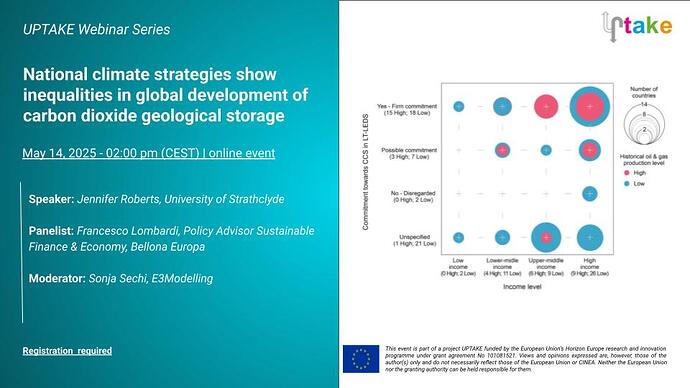The next webinar of the series on the latest published papers on carbon dioxide removal (CDR) research will focus on the paper: National climate strategies show inequalities in global development of carbon dioxide geological storage
 Speakers: Jennifer Roberts, University of Strathclyde
Speakers: Jennifer Roberts, University of Strathclyde
 Panelist: Francesco Lombardi, Policy Advisor Sustainable Finance & Economy, Bellona Europa
Panelist: Francesco Lombardi, Policy Advisor Sustainable Finance & Economy, Bellona Europa
 Moderator: Sonja Sechi, E3Modelling
Moderator: Sonja Sechi, E3Modelling
 14 May 2025, 2 pm - 3 pm (CEST) I ZOOM, online
14 May 2025, 2 pm - 3 pm (CEST) I ZOOM, online
Register in advance  here.
here.
 The webinar format will consist of a 20-minute presentation and a 10-minute discussion with an invited expert stakeholder, followed by a 30-minute open discussion (1 hour total).
The webinar format will consist of a 20-minute presentation and a 10-minute discussion with an invited expert stakeholder, followed by a 30-minute open discussion (1 hour total).
Learn more on the paper  here
here
2 Likes
Key Takeaways from the UPTAKE Webinar
Dr Jennifer Roberts (University of Strathclyde) presented findings from her recent paper, published in Nature Communications Earth & Environment and co-authored with Dr Juan Alcalde (Geosciences Barcelona) and Dr. Gareth Johnson (University of Strathclyde, Dax group), highlighting global inequalities in the inclusion of CO₂ geological storage (CGS) within Long-Term Low Emissions Development Strategies (LT-LEDS).
Key insights from the presentation and study are:
- While two-thirds of LT-LEDS mention CGS, most focus on fossil CCS, and only a minority include subsurface carbon dioxide removal (CDR) such as BECCS or DACCS. No country includes subsurface CDR without also including fossil CCS.
- High-income countries with a history of oil and gas production are far more likely to commit to CGS, reinforcing structural advantages and raising concerns about climate justice and equity.
- A key barrier is the lack of transparency, consistency, and detail in national LT-LEDS, which prevents meaningful comparison, tracking, and prioritisation across countries.
- The authors developed a database combining LT-LEDS content, fossil fuel legacy, and CO₂ storage indicators. Their analysis reveals that technical readiness does not always translate into political commitment, especially in low- and middle-income countries.
Dr. Sonja Sechi (E3Modelling), who moderated the session, pointed out that prioritising between fossil CCS and subsurface CDR is a strategic choice that should depend on each country’s specific context such as geological potential, industrial structure, and climate targets. However, such prioritization is often not made explicit in LT-LEDS. She asked how the database developed for the paper could support clearer strategic differentiation. Dr Roberts agreed that this is a key concern, and emphasized that more granular, standardized LT-LEDS are needed for guiding fairer investment decisions and enabling cross-country comparisons, but also to keep the database updated for new analyses and to provide more targeted insights for future prioritization.
Dr. Francesco Lombardi Stocchetti (Bellona Europa) addressed the challenges of financing CDR, noting that the discussion is still at an early stage, with few projects operating on the ground. He stressed the importance of investing in pilot initiatives that can demonstrate the effectiveness of CDR in practice.
Most of the audience showed interest in understanding the future role of CBAM, and Dr. Lombardi provided detailed explanations of its mechanisms and how it could potentially contribute to CDR financing.
He suggested that revenues from the EU ETS and the Carbon Border Adjustment Mechanism (CBAM) could be used to support such projects—on the condition that funding is tied to strong climate integrity criteria. To ensure that CDR investments contribute meaningfully to climate goals, he outlined four guiding principles:
- Real climate impact – Projects must result in actual net removal of CO₂ from the atmosphere, not merely avoid emissions.
- System alignment – CDR should support, not delay, broader efforts to decarbonize industrial sectors.
- Timeliness and scalability – Solutions should be deployable within the next two decades and at a scale that matters.
- Do No Significant Harm (DNSH) – All CDR activities must comply with environmental and social safeguards.
UPTAKE Seminar presentation.pdf (1.3 MB)
J Roberts_UPTAKE Webinar_May 2025_SHORT.pdf (3.4 MB)
Missed our last webinar?! Full recording now available 
![]() Speakers: Jennifer Roberts, University of Strathclyde
Speakers: Jennifer Roberts, University of Strathclyde![]() Panelist: Francesco Lombardi, Policy Advisor Sustainable Finance & Economy, Bellona Europa
Panelist: Francesco Lombardi, Policy Advisor Sustainable Finance & Economy, Bellona Europa![]() Moderator: Sonja Sechi, E3Modelling
Moderator: Sonja Sechi, E3Modelling![]() 14 May 2025, 2 pm - 3 pm (CEST) I ZOOM, online
14 May 2025, 2 pm - 3 pm (CEST) I ZOOM, online![]() here.
here.![]() The webinar format will consist of a 20-minute presentation and a 10-minute discussion with an invited expert stakeholder, followed by a 30-minute open discussion (1 hour total).
The webinar format will consist of a 20-minute presentation and a 10-minute discussion with an invited expert stakeholder, followed by a 30-minute open discussion (1 hour total).![]() here
here
